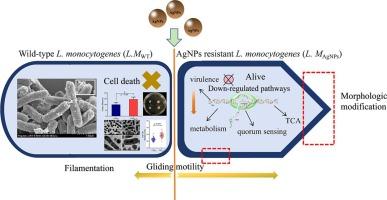单核细胞增生李斯特菌对银纳米颗粒的耐药性:形态学、毒力和细胞反应
IF 5.2
1区 农林科学
Q1 FOOD SCIENCE & TECHNOLOGY
International journal of food microbiology
Pub Date : 2025-07-24
DOI:10.1016/j.ijfoodmicro.2025.111365
引用次数: 0
摘要
细菌抗生素耐药性对全球健康构成日益严重的威胁。为了解决这一问题,银纳米颗粒(AgNPs)因其广谱抗菌活性而被广泛应用。然而,最近细菌中出现的AgNPs耐药性提出了一个关键的挑战,因为潜在的耐药机制仍然知之甚少。在本研究中,合成了球形柠檬酸盐包覆的AgNPs,平均粒径约为12 nm。单核增生李斯特菌对AgNPs (L.MAgNPs)反复暴露后产生耐药性,并通过表型和遗传变化研究其潜在机制。结果表明,长期暴露于AgNPs后,L.MAgNPs的杆状细胞的半球形极急剧变细,细胞壁厚度比野生型增加了约17.4%,p值小于0.0001。差异基因表达分析显示,L.MAgNPs中毒力基因的相对表达量显著下调(padj≤0.05)。暴露于AgNPs后,一些基因几乎不表达,qRT-PCR和溶血实验进一步证实了这一点。L.MAgNPs的滑行能力明显增强。基于这些研究,我们强调单核增生乳杆菌对AgNPs的抗性机制可能是由抗性菌株的尖尖极(使其更加坚硬)和毒力反应的改变和滑行运动的增强介导的,这与报道的AgNPs抗性不同。这项工作不仅促进了对病原菌抗菌应激反应与毒力之间关系的认识,而且通过阐明细菌耐药机制,促进了AgNPs的更安全利用。本文章由计算机程序翻译,如有差异,请以英文原文为准。

Silver nanoparticles resistance in Listeria monocytogenes: morphologic, virulence and cellular response
Bacterial antibiotic resistance poses a growing global health threat. To address this, silver nanoparticles (AgNPs) have been extensively applied for their broad-spectrum antibacterial activity. However, the recent emergence of AgNPs resistance in bacteria presents a critical challenge, as the underlying resistance mechanisms remain poorly understood. In this study, spherical citrate-capped AgNPs were synthesized with an average particle size of approximately 12 nm. Listeria monocytogenes developed resistance to AgNPs (L.MAgNPs) after repeated exposure, and the underlying mechanisms were investigated through phenotypic and genetic changes. The results showed that the hemispherical poles of rod-shaped cells became sharply tapered after long-term exposure to AgNPs, and the cell wall thickness in L.MAgNPs increased by approximately 17.4 % compared to wild type strain, with p ˂ 0.0001. Differential gene expression analysis showed that the relative expression of virulence genes was significantly down-regulated in L.MAgNPs (padj ≤ 0.05). Some genes were barely expressed upon exposure to AgNPs, and this was further validated by qRT-PCR and hemolysis assay. The gliding motility of L.MAgNPs was significantly increased. Based on these studies, we emphasize that the mechanism of AgNPs resistance in L. monocytogenes may be mediated by the sharp-tapered poles of resistance strain, which make them more rigid, and by altered virulence responses and enhanced gliding motility, which are distinct from the reported AgNPs resistance. This work not only advances the understanding of the relationship between antibacterial stress responses and virulence in pathogen, but also facilitates safer utilization of AgNPs by clarifying bacterial resistance mechanisms.
求助全文
通过发布文献求助,成功后即可免费获取论文全文。
去求助
来源期刊
CiteScore
10.40
自引率
5.60%
发文量
322
审稿时长
65 days
期刊介绍:
The International Journal of Food Microbiology publishes papers dealing with all aspects of food microbiology. Articles must present information that is novel, has high impact and interest, and is of high scientific quality. They should provide scientific or technological advancement in the specific field of interest of the journal and enhance its strong international reputation. Preliminary or confirmatory results as well as contributions not strictly related to food microbiology will not be considered for publication.

 求助内容:
求助内容: 应助结果提醒方式:
应助结果提醒方式:


